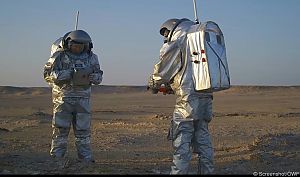Mars simulation: Analog mission "AMADEE-20" starts today

ÖWF will conduct the analog Mars field simulation in cooperation with the Israeli Space Agency ISA and the "Desert Mars Analog Ramon Station" (D-MARS) one year later than planned from October 4 to 31 due to corona conditions. More than 200 scientists from 25 countries are involved in the ÖWF's 13th Mars simulation.
The goal of the project is to simulate the work of astronauts - also in combination with the use of robots - in Mars-like environments on Earth. To this end, not only are new technologies being tested. Analog research also looks for weak points and errors in workflows and equipment "so that everything goes smoothly during the actual mission," says ÖWF head Gernot Grömer.
Habitat is located in Ramon crater
Six "analog astronauts" - one woman and five men - were selected and trained for the isolation part of the mission. They come from Austria, Germany, Israel, the Netherlands, Portugal and Spain. For three weeks, they will live in a habitat built specifically for the mission by D-MARS. It is located in the Ramon crater, the largest erosion crater in the Negev desert in the south of Israel, and will be used for further such missions after "AMADEE-20".
The habitat consists of a "Crew Module" with 50 square meters, which is used as a bedroom, lounge and kitchen for the six occupants. It is connected via a two-meter corridor to the Science and Command Module, which is about 60 square meters in size. This serves as a laboratory, science and command unit, storage and infirmary. The space suit simulator developed by the ÖWF, which the "analog astronauts" have to wear during "field missions," is also put on and taken off in this module.
During the first week, all the equipment is unpacked, set up and checked. During isolation, there is a team of five to ten people who do support work near the habitat, but without contacting the "analog astronauts." The team gets support in the desert from the Mission Support Center (MSC) team in Innsbruck, although there is a ten-minute delay built into the communication between the habitat and MSC. This is also how long a radio signal from Mars to Earth takes.
Detailed "flight plan" for the sequence of events
The sequence of the three-week isolation is meticulously specified in a "flight plan". It specifies in 15-minute steps who will do what and when, who will put on which space suit, and so on. As part of the project, more than two dozen international experiments are being conducted and various technologies tested. For example, an autonomous flying drone is being tested to help map unknown terrain and rescue lost astronauts. A team of researchers led by Stephan Weiss of Klagenfurt University, who was involved in the first flight of the "Ingenuity" helicopter on Mars this spring, plans to use the mission to gain further experience on how a drone can determine its location and navigate without GPS systems.
With the support of these two flying machines, a rover developed by researchers at the Graz University of Technology (TU) will prepare the field missions of the analog astronauts. Once again in use is an unusual spherical rover, more than two meters in diameter, from TU Vienna, inspired by tumbleweeds, a shrub that can travel long distances driven by the wind.
Use of 3D printers being tested
The user-friendliness of an airlock, a haptic remote control of a robot or ways to monitor contamination with microorganisms are also being tested. In cooperation with the European Space Agency (ESA), the use of 3D printers and innovative methods to make spacesuit underwear more hygienic and thus reusable several times in the future are also being tested. A protective vest that shields bone marrow and other organs rich in stem cells from harmful radiation is also being tested.
The mental and physical health of the analog astronauts is also a major topic. These range from studying the effects of isolation on a group's mental health, to techniques for positively influencing team performance, to monitoring the health of analog astronauts by controlling the frequency and consistency of their bowel movements.
